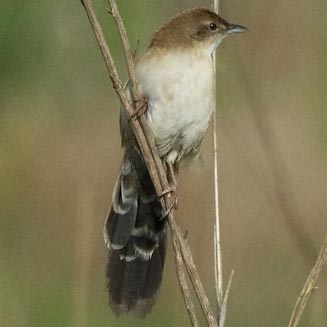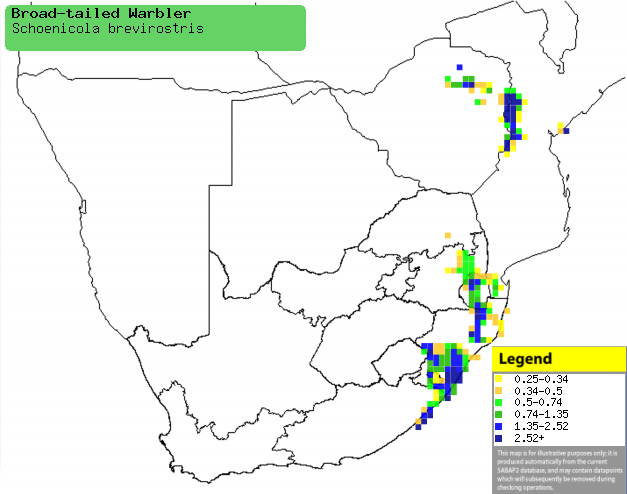|
Schoenicola brevirostris
(Broad-tailed warbler, Fan-tailed grassbird)
Breëstertsanger [Afrikaans]; Umvokontshi [Xhosa]; Qovo
[Tsonga]; Graminicole à bec court [French]; Breitschwanzsänger [German];
Felosa-de-cauda-larga [Portuguese]
Life
> Eukaryotes >
Opisthokonta
> Metazoa (animals) >
Bilateria >
Deuterostomia > Chordata >
Craniata > Vertebrata (vertebrates) > Gnathostomata (jawed
vertebrates) > Teleostomi (teleost fish) > Osteichthyes (bony fish) > Class:
Sarcopterygii (lobe-finned
fish) > Stegocephalia (terrestrial
vertebrates) > Tetrapoda
(four-legged vertebrates) > Reptiliomorpha > Amniota >
Reptilia (reptiles) >
Romeriida > Diapsida > Archosauromorpha > Archosauria >
Dinosauria
(dinosaurs) > Saurischia > Theropoda (bipedal predatory dinosaurs) >
Coelurosauria > Maniraptora > Aves
(birds) > Order: Passeriformes
> Family: Sylviidae
 |
|
|
Broad-tailed warbler, Cedara Farm, KwaZulu-Natal,
South Africa. [photo
Alan Manson
©] |
|
For information about this species, see
www.birdforum.net/opus/Fan-tailed_Grassbird
Distribution and habitat
It has localised populations scattered the DRC, extending
southwards through Angola and Zambia to southern Africa. Here it is generally
localised and hard to find, occurring in thick grassland in poorly drained areas
and along grassy hillsides.
|
 |
|
Distribution of Broad-tailed warbler in southern
Africa, based on statistical smoothing of the records from first SA Bird
Atlas Project (©
Animal Demography unit, University of
Cape Town; smoothing by Birgit Erni and Francesca Little). Colours range
from dark blue (most common) through to yellow (least common).
See here for the latest distribution
from the SABAP2. |
Food
It is insectivorous, feeding on
caterpillars, grasshoppers (Orthoptera)
and beetles (Coleoptera).
Breeding
- The nest is an untidy, thick-walled cup built with broad grass blades and
lined with finer grass. It is typically concealed in the center of a grass
tussock or between closely-packed grass stems.
- Egg-laying season is from November-April, peaking from November-January.
- It lays 2-3 eggs, which are incubated by a dedicated adult, who sits
tight even if touched or otherwise disturbed.
- Not much is known about the chicks, other than that they are fed by both
parents.
Threats
Not threatened internationally, but Near-threatened
in South Africa, probably due to the overgrazing, frequent burning and trampling
of its preferred grassland habitat. It is however well-represented in protected
areas.
References
-
Hockey PAR, Dean WRJ and Ryan PG 2005. Roberts
- Birds of southern Africa, VIIth ed. The Trustees of the John Voelcker
Bird Book Fund, Cape Town.
|
